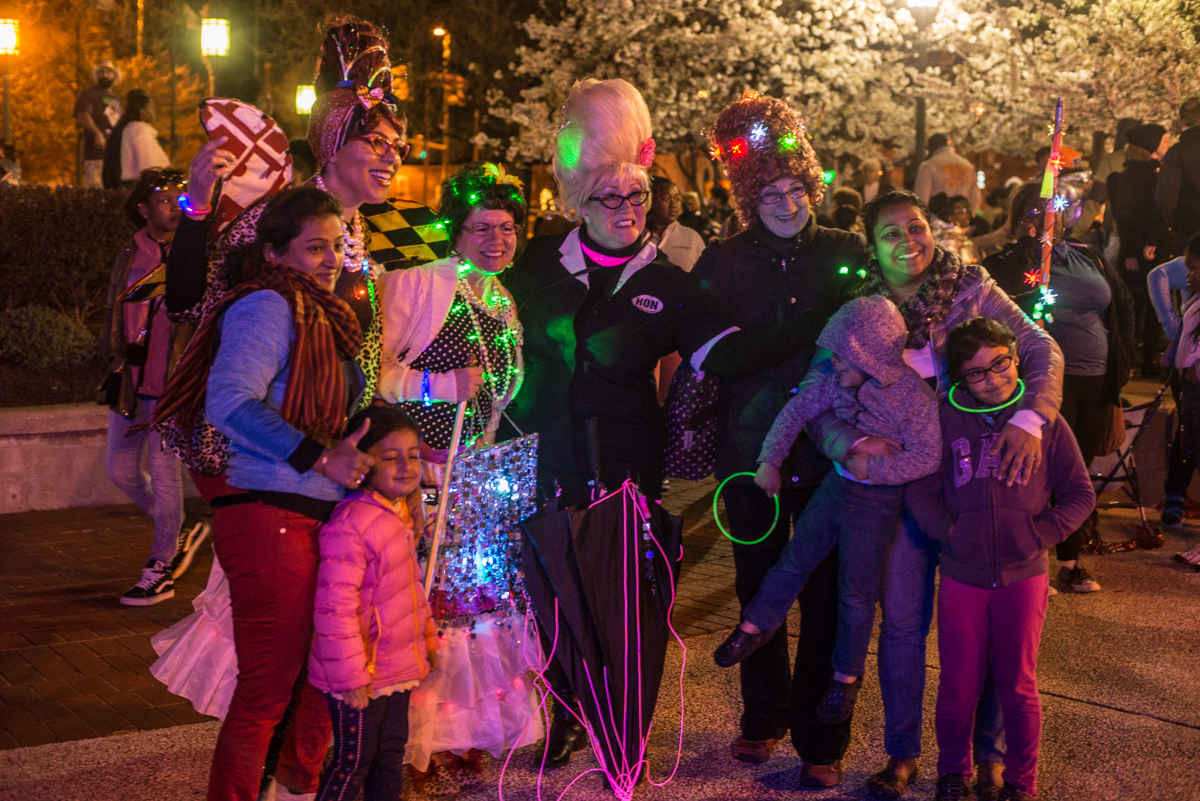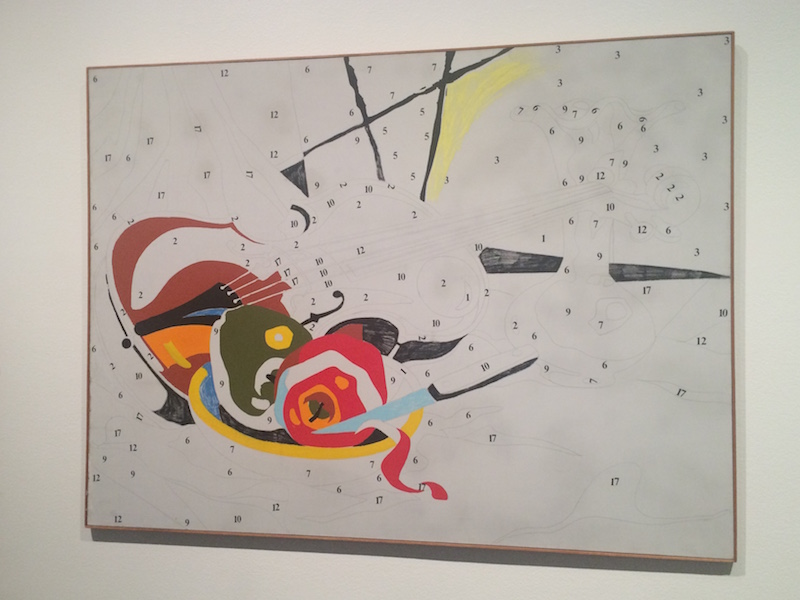Thank you, Paul Rucker and John Somers, for making my first two visits to Light City Baltimore worthwhile. I don’t know exactly what I was expecting from the festival itself but after wandering around it for about two and a half hours on each of its first two nights, I think I greatly overestimated its size, scope, and vision. I mean, I feel like I have been hearing about it pretty steadily since the Sun first wrote about it in February 2015.
The fest’s budget figures have tossed around $4 million estimates, raised through private donations. Last spring and summer the festival’s social media channels talked about its community planning meetings and calls for artists. When the lineups were announced last fall it sounded big: 29 original works of “light art” and some 50 concerts and 100 performances, along with its ticketed innovation conference. And over the past few months its media rollout has felt inescapable. The festival even has a freaking app (which I can’t use because my DumbPhone can’t upgrade to iOS 8). But while wandering up and down its 1.2-mile footprint around the Inner Harbor on Monday and Tuesday nights I kept wondering, Is this it?
In fact, while making my first pass through I was reminded of that episode of Buffy, the Vampire Slayer where the Scoobies spend the entire hour trying in vain to prevent the appearance of some demon. When the ugly creature from an evil dimension does appear, he’s about the size of a toy, causing one of the gang to quip something along the lines of, “Big fanfare . . . little finish,” right before Buffy stomps on him. So clowning on Light City—and, I have to confess, I left my apartment Monday night fully thinking I was going on a fact-finding mission to hate on this thing with extreme prejudice (I just can’t with the “light art”)—would feel a bit like making fun of Eeyore. Light City is less a Grand Prix of Baltimore-scale epic fail and more like those off-brand carnivals that used to set up in the old Eastern High School parking lot across from Memorial Stadium. You can even get cotton candy. Served atop sticks with lights, natch.
If that home-school-simple scale was intentional, it was a smart move. Navigating the Inner Harbor during Light City is no more or less annoying than usual. But I have to admit I was expecting some aspect of it to be more interesting—or at least making some effort to be visually grand. In my brain “light art” of this variety operates like Olympic games opening ceremonies, and there’s not a single piece here that even aims for that level of artifice. For better and worse the work from the visual artists is by and large innocuous. Some are interesting, some are imaginatively conceived, and some are incredibly thoughtful, but nothing so far has totally grabbed my eyeballs. More distressingly, everything installed for Light City Baltimore looks more visually interesting as a hashtagged shared pic than it does in real life.
OK, full disclosure: I find the very idea of the “light art” peddled by light art festivals to be visually tepid, so understand that I’m coming at all this from a biased and pretentious place. I see images from Vivid Sydney, the festival Light City organizers cited as an inspiration, and all I think is that “light art” of this ilk is just a Cow Parade for the 21st century.
Yes, there are a few light festivals around the globe with longstanding historical roots—see: Lyon’s Fête des Lumières, and we’re going to come back to this notion of “historical roots” in a bit—but most are of a more recent vintage. And they’re everywhere. It’s not that they can’t be interesting—Thomas Schielke writes about architectural lighting at ArchDaily, and in this 2013 post he examines four different light festivals with four different focuses—but the blatant tourism aspect of these events is pretty shameless. The International Light Festival Organization lists 11 light fests happening this year alone in Europe.
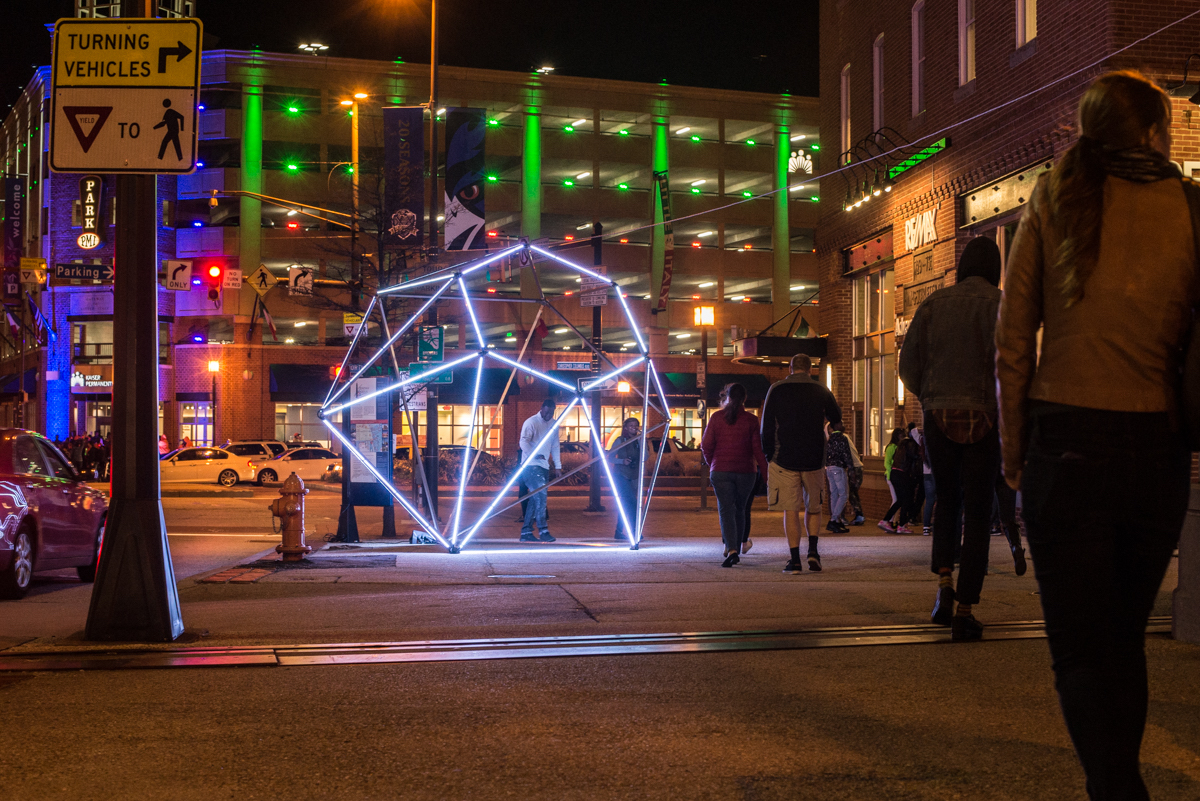
But, hey, I’m a snob. Thankfully many of the participating local artists aren’t. Scott Pennington’s structures installed in the plaza by the World Trade Center is what initially planted the carnival aspect of Light City in my brain. His works are midway-like gates and shapes festival attendees appear to enjoy walking among. That romper-room playfulness animates Mina Cheon and Gabriel Kroiz’s diamond lights, which dot the walkways heading from Pier 5 to Harbor East. People appear to enjoy getting their photo taken standing inside of these large, illuminated diamond shapes, but I’m not buying their ostensible referencing to CitiWatch‘s surveillance system and the blue lights associated with them. That’s a specious symbolism not earned by experiencing the works in person, as they fit all too comfortably among the rest of the bright and shiny nonsense at the Inner Harbor, void of tensions.
The Inner Harbor setting, in fact, can’t be ignored or even muted, much less transcended. Not only do all of its corporate entertainment, retail, and restaurant signage possess a similar illumination palette as the Light City artworks, they’re all an order of magnitude larger than every piece in the festival. The environment just devours everything in sight, and any piece with a touch of nuance about its articulation or concept feels nearly inert.
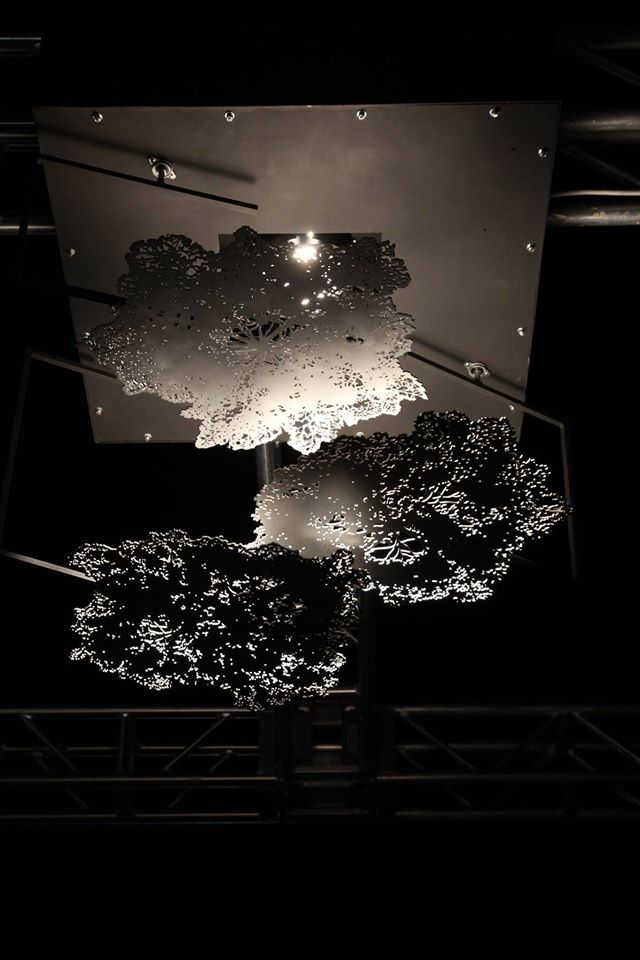
Take Lisa Dillin’s “Natural Lighting Emulator V.” For it Dillin has made a series of slowly rotating discs that have holes, shapes, slits cut into them; as they slowly turn overhead the light passing through them becomes diffuse, the way sunlight does passing through a tree canopy. This piece is exactly the kind of acutely observed, inspired use of a material to evoke the natural world that Dillin does so exceptionally well. But installed maybe 10 meters away from the entrance to Family Meal, it feels and looks like the outdoor smoking area, a place to burn one with just enough light to check Facebook while doing so.
The same could be said for Robby Rackleff’s “Pyrrha” or Greg St. Pierre and Andrew Bernstein’s “Water Wall,” which are both projection and sound installations. The former uses the visual language of glitchy computer graphics and is installed on a bridge by the former Public Works Museum. The latter sits in the harbor off the promenade behind the Four Seasons Hotel in Harbor East, and it projects images onto a spray of water shooting into the air. Both are the kinds of ideas and scales that would stun in any kind of gallery setting; at the Inner Harbor they feel like the sorts of mild divertissements that are there all the time. Here you go hip, young customers of Wit & Wisdom, the official bar of Light City. Partake of house-crafted infusions such as bacon-washed bourbon and seasonal cocktails such as an Asian pear mule while enjoying the pretty lights we had local artisans craft for your amusement.
* * *
Now, about those historical roots. Practically since its public debut the fest’s press materials have touted: “In 1816, Baltimore was the first American city to illuminate its streets with gas lanterns, revolutionizing the urban landscape forever by transforming the city with light.”
I’m not entirely convinced that’s accurate. Yes, on June 11, 1816, Baltimore businessman-slash-artist Rembrandt Peale used gaslights to illuminate galleries—or a gallery, I haven’t been able to determine if it was one or more rooms—in his for-profit museum located at 225 North Holliday Street downtown, the site where artist Abigail DeVille is installing Only When It’s Dark Enough Can You See The Stars, her new body of work as a project of the Contemporary. Peale was part of a five-man business team that formed the Gas Light Company of Baltimore—the company that would become Baltimore Gas and Electric—in June 1816, and it set to work laying pipe that would run gas through the city. As noted in an October 10, 1998, Baltimore Sun article by Frederick Rasmussen, “[i]n 1817, the new company was contracted by the city to erect its first gas light at the corner of Market and Lemon streets, today Baltimore and Holliday streets.”
Rasmussen continued:
“At the end of World War II, there were some 16,000 gas lamps still in operation in Baltimore. By the early 1950s, when Mayor Thomas D’Alesandro began conversion of the city’s lighting to mercury vapor lamps, there were still more than 10,000 gas lamps casting their wonderful soft, yellow-greenish light across the city.
It was on Aug. 14, 1957, that D’Alesandro extinguished the city’s last gas lamp in Little Italy, thus ending the city’s 140-year affair with gas illumination.”
 “Mayor Thomas D’Alessandro (R fore) during a meeting on how to clean up slums.” (Photo by Mark Kauffman//Time Life Pictures/Getty Images)
“Mayor Thomas D’Alessandro (R fore) during a meeting on how to clean up slums.” (Photo by Mark Kauffman//Time Life Pictures/Getty Images)
Elsewhere in the Sun‘s archives, a letter appeared in the November 10, 1957, edition that brought up conflicting sources as to who had the first gas lights in the U.S., Baltimore or Richmond, Va. Depending on what sources you check today, that question hasn’t been entirely settled.
I’m not mentioning these factoids here merely to be a prick—marketing claims probably don’t get fact checked—but to mention how events such as Light City Baltimore participate in history rewriting whether they are intentionally trying to or not. I don’t know if the fest’s organizers tried pitching the festival to local civic and business leaders without the bicentennial hook, but I do wonder if this historical truthiness makes it a juicer sell. Because the festival wasn’t marketed as, We want to have a light festival because we think it’s cool. Instead, part of what’s being sold with this festival is the idea that Baltimore was an innovator of something at some point in time and, ergo, it can be again. We should remember this great moment in the past and use it as a springboard into the future. Light City is one of many ways a city’s past gets retold to remake a possible future for itself.
Of course, the complications come in when we starting getting down into the particulars of whose past we’re talking about, whose future, and who gets to decide, participate, and profit from the making of that future. Right now Light City is but a small plot point in the ongoing postmodern novel that is Baltimore’s central business district in the postwar era. (See David Harvey’s “A View from Federal Hill” for a different chapter.) And it’s following in the footsteps of many chapters that use “art,” vaguely defined, as a black box to generate tourism revenue.
That’s a predatory strategy that I’ve suggested elsewhere doesn’t work. What I didn’t mention then is that the strategy more consistently than not makes utterly underwhelming art, an argument that this light festival does little to dispel.
Light City, however, is taking place in a post-uprising Baltimore where its citizens are refreshingly wrestling with and reckoning the city’s past. And wandering around the fest and then doing some cursory reading about city’s gaslight history, briefly excerpted above, didn’t have me thinking about the Baltimore of 1816. The Baltimore that the festival sifted to the surface was that of the Mayor D’Alesandro that extinguished that last gaslight, and the ways power players in Baltimore, and the vision they produce for the city, remain concentrated in such a tiny pool of people.
Consider: Mayor Thomas D’Alesandro Jr. was the father to both Minority Speaker of the House Nancy Pelosi and Thomas L. J. D’Alesandro III, the city’s mayor from 1967 to 1971. That D’Alesandro returned to the newscycle over the past year because he occupied City Hall during the uprising that ran April 6-14, 1968, following the assassination of Dr. Martin Luther King, Jr. He was succeeded by William Donald Schaeffer, the four-term mayor who oversaw the habor’s transformation into a tourist mecca. Thomas L. J. D’Alesandro was also mayor when the Morris A. Mechnic Theatre opened in 1966.
I’m wicked cheap, so when I went to Light City I parked a good stroll away from the Harbor and not at one of the garages charging roughly $20 for the night. And while heading back I walked by the site of the old Mechanic. I usually pass through downtown by bus, cab, or bike, and I’m rarely around this area at night, so I hadn’t seen the destruction up close and personal, when it is slightly illuminated by the ambient glow of nearby streetlights and buildings. I’m no champion of Brutalism, but walking by the hole in the ground stopped me in my tracks—simply because for a few years I would sit behind the theater waiting for a phone to ring.
When I worked as a bike messenger in the pre-cell phone and hand-radio days of the early-to-mid 1990s, a pair of pay phones behind the Mechanic was where you were sent if you ended up clear of deliveries downtown. You and whoever else was clear would sit around, lean your bikes up against a concrete slab, and shoot the shit, grab a quick bite, smoke, whatever, until the phone rang and you got a pickup. I spent many days chilling there in good weather and bad. If it was wintry wet you were looking to get moving as quickly as possible. On slow, sunny days you didn’t mind the downtime.
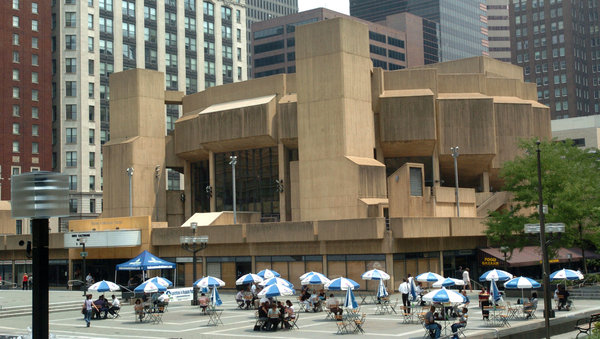
Maybe you’d get lucky and the law firm of Venable, Baetjer, and Howard, now known as Venable LLP, would have a stack of filings that needed to get run up to the State Department of Assessments and Taxation at 301 West Preston. Multiple stops at the same address were easy money. I remember one slow spring day a number of us pooled up a nice chunk of change that would be awarded to the first of us able to ride our bike down the up-moving escalator that climbed up from the underground parking lot. Nobody dared try, though a few of us stood at the top looking down, trying to determine just how wrong it could go.
I hadn’t thought about of such things since the ’90s. I didn’t live down there. I didn’t even work at a nearby office building. I merely spent some time there off and on during the years I worked as a bike messenger in college because the money was better than waiting tables. And the sight of its annihilation triggered a small but potent wave of nostalgia.
What if this destruction took place in my neighborhood? What if where I grew up looked like this? That’s what EBDI and the Johns Hopkins University (note: I’m a Hopkins alumnus who now works for the university, and it is a Light City sponsor) did to the Middle East neighborhood when in 2001 they identified 750 households for removal to redevelop 88 acres of East Baltimore. That’s what the city did to Harlem Park in 1969 when it wanted to build a highway connecting the central business district, where renewal investment was taking place, to Interstate Highway 70 in Howard County, destroying more than 950 homes, more than 50 businesses, and displacing roughly 1,500 people. Both are/were economic development projects designed in full cooperation with civic and business leadership.
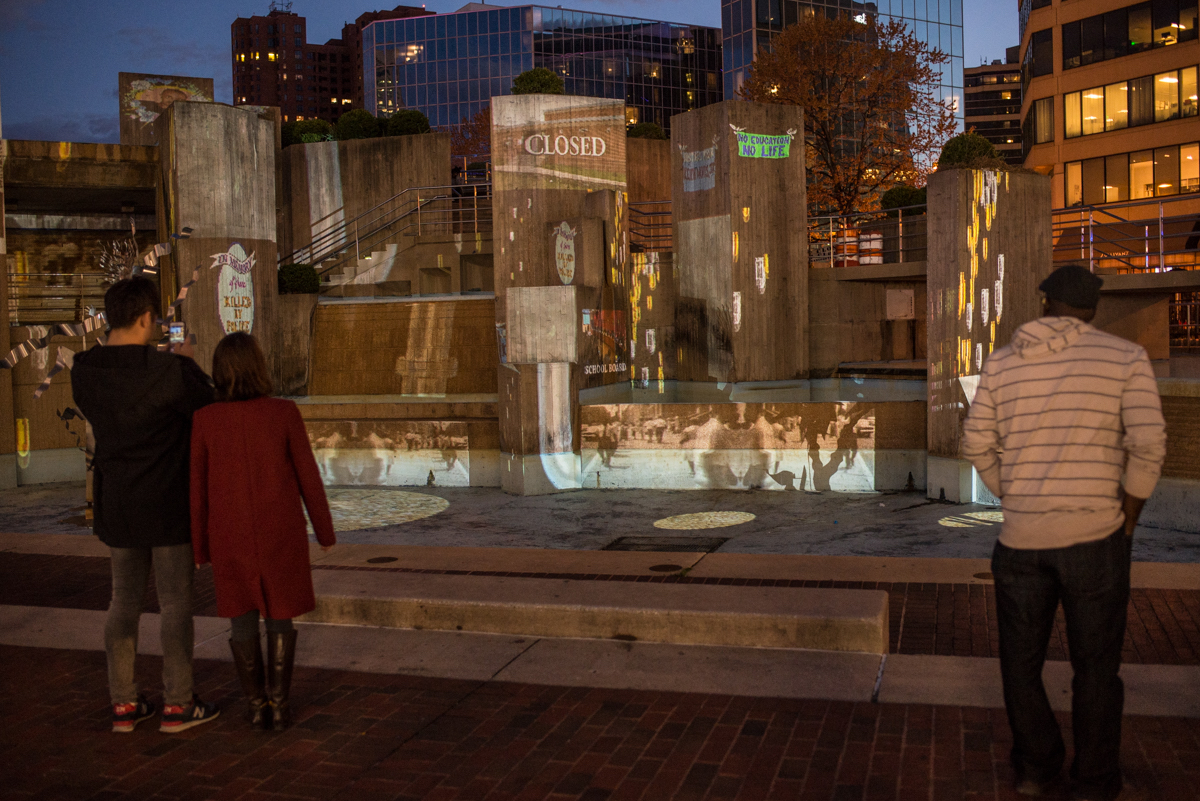
In both instances the populations affected were overwhelmingly African-American. Previous commitments prevented me from getting down to Light City on Wednesday night, where Luminous Intervention’s “Pipelines” installation at McKeldin Square—which involves projecting the faces of victims of police violence onto the fountain’s concrete walls—coincided with the 140th West Wednesday, the weekly event held by the activists who have fought for justice in the murder of Tyrone West by police on July 18, 2013. On Monday night at this site I caught a bit of a forum on police violence and on Tuesday some of the music performances—Son of Nun and Dev Rock, I think. The installation is, thus far, the rare work and public space at Light City that addresses the uprising, the urban policies and practices that created and sustain the violence of economic disinvestment, and the citizens affected by it in any meaningful way.
Light City hasn’t been coy about the fact that it’s hoping to boost tourism in and around the Inner Harbor during its week-long run, hoping to draw 350,000 visitors to the area. In the 1970s and ’80s the Mechanic was part of the city’s tourism industry, too, managed by a quasi-public corporation that also ran the Pier 6 concert pavilion. At one time the Mechanic was considered such a part of the city’s entertainment package that Omni International Hotel began targeting entertainment tourists in the late 1980s, and planned to make a “Skywalk to the Stars” attraction on the walkway that once passed over Baltimore Street. “We feel that Baltimore is increasingly becoming an entertainment attraction,” Henry J. Knott, president of the development company that owned the Omni, told The Sun in 1988.
While I was standing by the Mechanic—I mean, the massive hole in the ground where this entertainment attraction once stood, the bikes modified by Thick Air Studios, a Light City participant, rode by. It was a group of cyclists whose bikes had flags attached to them that each bore a red neon letter. Together they spelled out DEAR BALTIMORE. Well, I found out the next night they were supposed to spell DEAR BALTIMORE when I saw them again. That night the first few riders got a little jumbled, and what rode up Charles Street and eventually turned left onto Fayette read DARE BALTIMORE. If only.
Had I any electrical know how, creative chutzpah, cash that wasn’t going toward debt, and didn’t fear authorities, I’d look into finding a way to illegally illuminate the Mechanic hole in the ground as a kind of guerilla Light City installation. Just obnoxiously flood it with klieg lights and get a bunch of those glowstick rave necklaces and use them to spell out TOURIST ATTRACTION in the chain-link fence that surrounds the site. Because that’s all our tourism-dependent economic development strategy is doing for us: creating large-scale event holes in the ground into which we hope people and businesses pour money, funds that never actually reach or sustain the citizenry at large, until these things become of no use to the city’s civic and business elite.
* * *
Luminous Intervention’s “Pipelines” isn’t the only politically modulated Light City installation that works. Paul Rucker’s “In Light of History” does a fair job of tapping into the city’s checkered past. For “In Light” Rucker has installed a small street light at 11 places along Pratt Street that were sites of businesses involved in the slave trade. The light posts are modest, maybe six feet tall, and their lights are glowing areas that slowly change colors. Each lamppost supposedly had a pamphlet Rucker designed about this slave trade history, but even by 8:30 p.m. on Monday night I didn’t come across a single post that still had this publication in stock.
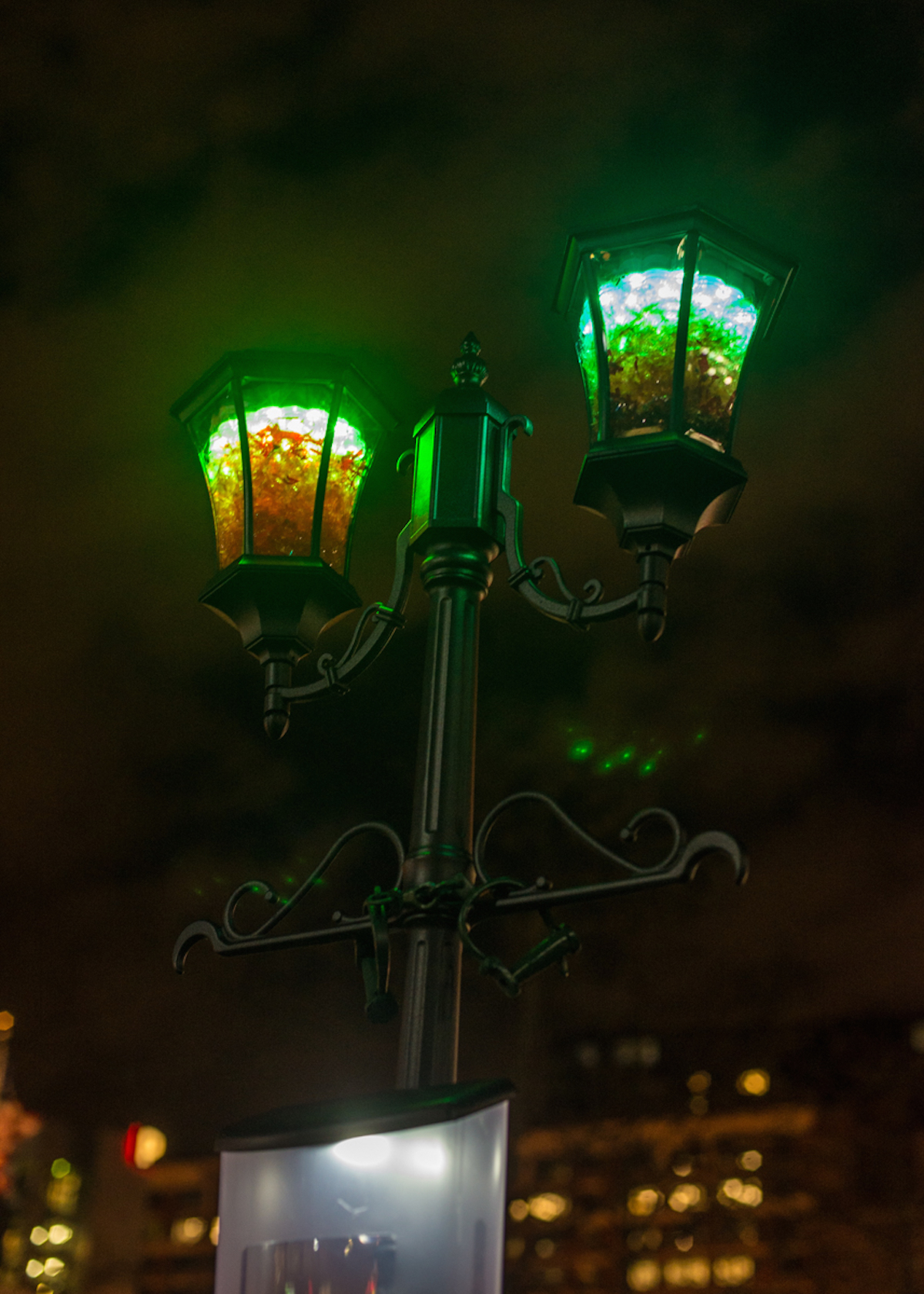
“In Light of History” is the lone Light City installation that I’ve come across thus far where the Inner Harbor’s overbearing presence amplifies the work’s thematic intent. Rucker’s lampposts are easy to walk right by and not even notice. Or you might see one and think it’s just a different kind of sandwich-board placard for one of Pratt Street’s many chain stores. Is this lamp telling me where the Starbuck’s is or where human beings profited from the selling of other human beings? Both.
Rucker’s performance on Monday night, however, was just a breath of fresh air. He set up with his solo cello right there at the Inner Harbor amphitheater where Light Street bends into Pratt, a pond of blinking star lights surrounding him. He announced that he wrote a piece of music for each of the sites in his installation and was going to play three of them, and the first went off without a hitch. The next two were plagued by technical difficulties—a looping pedal wasn’t working appropriately—and he eventually ended his set playing the prelude from Bach’s Cello Suite No. 1 (I think, my classical music knowledge isn’t what it should be).
But despite the technical difficulties, Rucker was everything the festival needs more of: genuine joy, sincere interactions with attendees, and above all a respect for the intelligence of the general public. He talked about liking the family friendly festival because kids were up late and out of the house with their parents, and toward the end of his set he invited all of the age seven-and-under tykes up to grab one of the blinking stars that surrounded him, causing the kind of adorable chaos that ensues anytime a group of starter humans trundle about. He asked the crowd history questions—What year and amendment gave women the right to vote? (1920, the 19th Amendment) What year was the Emancipation Proclamation issued? (1863) What year did Maryland outlaw slavery? (1864)—and people yelled out answers. The entire set never once felt like an eager-to-entertain tourist sideshow, and was a brief moment of good-natured fun in the presence of a grown-up human who happens to be an artist.

John Somers’ performance on Tuesday night was something else entirely. The guitarist/electronic artist was joined by Liz Meredith, with whom he put out the five-LP drone monolith The Disposition of Vibrant Forms in 2013, and three other musicians: two flutists and somebody who switched from xylophone to musical saw. Somers and Meredith set up their gear on the street in front of the Concert Stage at Harbor East, located at the intersection of Lancaster Street and Central Avenue.
Somers’ laptop played a gurgling a wash of shifting sounds and textures, which he augmented with barely perceptible electric guitar hums and buzzes, sustained notes he sang through a megaphone while walking through the crowd, and melodica. Meredith alternated between two different violins and also wandered through the crowd bowing long notes. Ditto the two flutes and the xylophone/musical saw player. They all held single notes with no perceptible shape or structure to the composition, and for long stretches they were standing or walking among the twenty to thirty attendees milling about taking in this gentle ooze and staring at a bunch of gear sitting on the pavement.
And they kept this up for nearly an entire hour. It felt like part endurance test, part radically sheepish disdain for the festival’s middlebrow commercialism. When I turned around to see what one of the musicians was doing behind me, my eyes inevitably tilted up to see the Legg Mason Tower. Following one of the flutists as she distractedly walked east down Lancaster and my eyes came to alight on the under-construction Harbor Pont monstrosity that the city awarded $107 million in TIF funding in 2013—the largest TIF request to the city prior to Under Armor asking for $535 million earlier this month.
And down there on the streets of Harbor East, where you typically hear some kind of radio-friendly pop flotsam floating out from a bar or car, five musicians performed an uncompromising, hour-long drone that wrapped itself around the head like a bucket of gelatin. Joggers passed through. People wearing workout lycra stopped by to stare for a few minutes at a time. Three people, shit you not, tossed a Frisbee around. One couple made out. Occasionally loud sounds from some place down the street or around the corner cut through the drone. Real-ass yuppies sat on the patio of Ouzo Bay next to some fake-ass fire while drinking red wine.
At one point a street cleaner came through, grabbed a cup with one of those metal claw thingies, and then accidentally dropped the cup, which bounced around the street and became the only rhythmic element my ears had heard in what felt like a lifetime. Somers and company didn’t jibe with any aspect of Light City I had experienced thus far, and not only am I glad they were a part of this festival, I kinda hope Somers recorded the performance and Bandcamp releases it with the Eno-ish title Music for Branding Campaignsjust to complete the apathetic middle finger of the performance’s entire steez.
That said, I’m still looking forward to a hitting a few things, such as Friday’s Open Beats hosted by the Llamadon Collective over by Mondawmin Mall and the LabBodiesperformance in Station North, the Saturday event at the Clifton Park bandshell and Dan Deacon that night—chiefly because the performances have been the most satisfying events thus far. (Note: I’m not attending any of the conferences for lack of interest and, frankly, it takes a certain amount of temerity to hold a conference that claims to “focus on promise in overlooked neighborhoods” and charge $200 to get in, so I couldn’t afford to go even if I were curious.)
I just wish the light art was more interesting, or more interestingly installed, but that would mean moving it away from the Inner Harbor’s gaping maw of mediocrity. Even something that should be compelling, like the “Lightwave: Baltimore’s Beacon” combination of oral histories and dancing light, ends up feeling like a highway traffic sign. Light City isn’t bad; merely inconsequential. And I shudder to think what artists and communities could actually do with a fraction of the capital that went into this tourism gamble—what would a Transmodern or Abdu Ali’s talk about making Kahlon a festival look like with a $100,000 cash infusion? I don’t know. I’m pretty sure that neither would aspire to bring some 350,000 people to the city. But I’m also not convinced that bringing 350,000 people to the city is a good enough reason to sink any amount of capital into the creation of middling spectacle.
